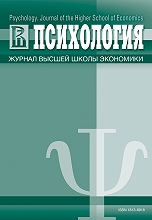Outdoor Pastimes of Children and Teenagers
Abstract
The article is about the content and the role of the outdoor pastimes in socialization of children and teenagers from different generations. The results of the content-analysis of the survey are presented, which was composed by the two specially developed questionnaires, filled in by 251 respondents of various ages. The main activities are considered that constitute children’s outdoor pastimes. Five main categories are identified: games (with rules, sport games, role plays etc.); exploration of environment (experiments, searches, gathering, construction etc.); risk (various risky episodes); communication with peers; culturally mediated activity (visits to museums, skating rings, etc.). The main constituents of each of five categories and their representation among answers of the adult and adolescent samples are described. The dynamics of the children’s outdoor pastime is characterized by the social tendencies of the XX and XXI centuries, such as the increase of social tension and uncertainty, urbanization, overpopulation, etc. The differences in the outdoor pastimes between generations are shown, which lie in the chronology of mastery of the outdoor space and the content of children’s outdoor pastimes. The role of the outdoor pastimes in socialization of children and teenagers is discussed. The areas of the main types of children’s outdoor activity are characterized, as well as the degree of awareness and control by parents over the children’s activities, versions of parental rules and restrictions on children’s moves and activities. The way how the idea of the world that is appealing and encourages knowledge changes into the idea of its dangerousness, is viewed. The perspectives of the further psychological research in this area are described.
Downloads
References
2. Бочавер, А. А. (2015). Представления о доме как элемент персонального опыта. Психологический журнал, 36(4), 5-15.
3. Нартова-Бочавер, С. К. (2012). Физическая школьная среда как предиктор здоровья и благополучия субъектов образовательного процесса (обзор зарубежных исследований). Клиническая и специальная психология, 1. Режим доступа: http://psyjournals.ru psyclin/2012/n1/49968.shtml
4. Осорина, М. В. (2008). Секретный мир детей в пространстве мира взрослых. СПб.: Питер.
5. Поливанова, К. Н. (2016). Детство в меняющемся мире. Современная зарубежная психология (электронный научный журнал), 5(2), 5-10. Режим доступа: http://psyjournals.ru/jmfp/2016/n2/82357.shtml
6. Радина, Н. К. (2012). Социальная психология городского образа жизни: город страха. Социальная психология и общество, 1, 126-141.
7. Хломов, К. Д., Кондрашкин, А. В., Кузин, П. А., Калякина, С. М., Тюльканова, К. И., Медведев, Д. П. (2014). Подросток в онлайн игре: включенное наблюдение и опыт социальной работы. Психологическая наука и образование http://psyedu.ru (электронный научный журнал), 6(4). Режим доступа: http://psyedu.ru journal/2014/4/Khlomov_Kondrashkin_Kuzin.phtm





